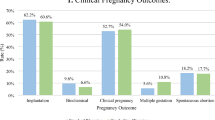Abstract
Objective
To evaluate the risk of ectopic pregnancy of embryo transfer.
Design
A retrospective cohort study on the incidence of ectopic pregnancy in fresh and frozen-thawed embryo transfer cycles from January 1st, 2010, to January 1st, 2015.
Patients
Infertile women undergoing frozen-thawed transfer cycles or fresh transfer cycles.
Intervention
In-vitro fertilization, fresh embryo transfer, frozen-thawed embryo transfer, ectopic pregnancy.
Main Outcome Measures
Ectopic pregnancy rate and clinical pregnancy rate.
Result
A total of 69 756 in vitro fertilization-embryo transfer cycles from 2010 to 2015 were analyzed, including 45 960 (65.9%) fresh and 23 796 (34.1%) frozen-thawed embryo transfer cycles. The clinical pregnancy rate per embryo transfer was slightly lower in fresh embryo transfer cycles compared with frozen-thawed embryo transfer cycles (40.8% vs 43.1%, P <.001). Frozen-thawed embryo transfer is associated with a lower incidence of ectopic pregnancy per clinical pregnancy, compared with fresh embryo transfers (odds ratio = 0.31; 95% confidence interval = 0.24-0.39). Female age and body mass index have no influence on ectopic pregnancy. In the frozen-thawed embryo transfer cycles, blastocyst transfer shows a significantly lower incidence of ectopic pregnancy (0.8% vs 1.8%, P =.002) in comparison with day 3 cleavage embryo transfer.
Conclusion
The risk of ectopic pregnancy is lower in frozen-thawed embryo transfer cycles than fresh embryo transfer cycles, and blastocyst transfer could further decrease the ectopic pregnancy rate in frozen-thawed embryo transfer cycles.
Similar content being viewed by others
References
Perkins KM, Boulet SL, Kissin DM, Jamieson DJ; National ART Surveillance (NASS) Group. Risk of ectopic pregnancy associated with assisted reproductive technology in the United States, 2001–2011. Obstet Gynecol. 2015;125(1):70–78.
Bouyer J, Coste J, Shojaei T, et al. Risk factors for ectopic pregnancy: a comprehensive analysis based on a large case-control, population-based study in France. Am J Epidemiol. 2003;157(3):185–194.
Chang HJ, Suh CS. Ectopic pregnancy after assisted reproductive technology: what are the risk factors? Curr Opin Obstet Gynecol. 2010;22(3):202–207.
Marcus SF, Brinsden PR. Analysis of the incidence and risk factors associated with ectopic pregnancy following in-vitro fertilization and embryo transfer. Hum Reprod. 1995;10(1):199–203.
Shapiro BS, Daneshmand ST, De Leon L, Garner FC, Aguirre M, Hudson C. Frozen-thawed embryo transfer is associated with a significantly reduced incidence of ectopic pregnancy. Fertil Steril. 2012;98(6):1490–1494.
Huang B, Hu D, Qian K, et al. Is frozen embryo transfer cycle associated with a significantly lower incidence of ectopic pregnancy? An analysis of more than 30,000 cycles. Fertil Steril. 2014;102(5):1345–1349.
Baczkowski T, Kurzawa R, Glabowski W. Methods of embryo scoring in in vitro fertilization. Reprod Biol. 2004;4(1):5–22.
Decleer W, Osmanagaoglu K, Meganck G, Devroey P. Slightly lower incidence of ectopic pregnancies in frozen embryo transfer cycles versus fresh in vitro fertilization-embryo transfer cycles: a retrospective cohort study. Fertil Steril. 2014;101(1):162–165.
Liu N, Ma Y, Li R, et al. Comparison of follicular fluid amphiregulin and EGF concentrations in patients undergoing IVF with different stimulation protocols. Endocrine. 2012;42(3):708–716.
Wang L, Qiao J, Liu P, Lian Y. Effect of luteinized unruptured follicle cycles on clinical outcomes of frozen thawed embryo transfer in Chinese women. J Assist Reprod Genet. 2008;25(6):229–233.
Ishihara O, Kuwahara A, Saitoh H. Frozen-thawed blastocyst transfer reduces ectopic pregnancy risk: an analysis of single embryo transfer cycles in Japan. Fertil Steril. 2011;95(6):1966–1969.
Wang ET, Kathiresan ASQ, Bresee C, Greene N, Alexander C, Pisarska MD. Abnormal implantation after fresh and frozen in vitro fertilization cycles. Fertil Steril. 2017;107(5):1153–1158.
Fang C, Huang R, Wei LN, Jia L. Frozen-thawed day 5 blastocyst transfer is associated with a lower risk of ectopic pregnancy than day 3 transfer and fresh transfer. Fertil Steril. 2015;103(3):655–661.e3.
Weiss A, Beck-Fruchter R, Golan J, Lavee M, Geslevich Y, Shalev E. Ectopic pregnancy risk factors for ART patients undergoing the GnRH antagonist protocol: a retrospective study. Reprod Biol Endocrinol. 2016;14:12.
Lyons RA, Saridogan E, Djahanbakhch O. The reproductive significance of human Fallopian tube cilia. Hum Reprod Update. 2006;12(4):363–372.
Wanggren K, Lalitkumar PG, Stavreus-Evers A, Stabi B, Gemzell-Danielsson K. Prostaglandin E2 and F2alpha receptors in the human Fallopian tube before and after mifepristone treatment. Mol Hum Reprod. 2006;12(9):577–585.
Healy MW, Patounakis G, Connell MT, et al. Does a frozen embryo transfer ameliorate the effect of elevated progesterone seen in fresh transfer cycles? Fertil Steril. 2016;105(1):93–99.e1.
Rombauts L, McMaster R, Motteram C, Fernando S. Risk of ectopic pregnancy is linked to endometrial thickness in a retrospective cohort study of 8120 assisted reproduction technology cycles. Hum Reprod. 2015;30(12):2846–2852.
Author information
Authors and Affiliations
Corresponding author
Rights and permissions
About this article
Cite this article
Zhang, X., Ma, C., Wu, Z. et al. Frozen-Thawed Embryo Transfer Cycles Have a Lower Incidence of Ectopic Pregnancy Compared With Fresh Embryo Transfer Cycles. Reprod. Sci. 25, 1431–1435 (2018). https://doi.org/10.1177/1933719117746759
Published:
Issue Date:
DOI: https://doi.org/10.1177/1933719117746759




